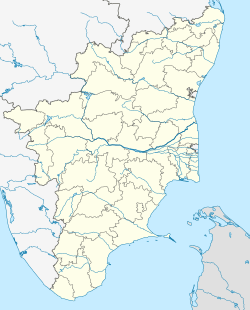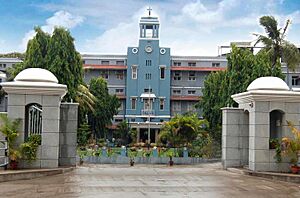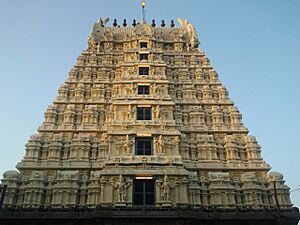Vellore facts for kids
Quick facts for kids
Vellore
Velur
|
|
|---|---|
|
|
|
| Nickname(s):
Fort City / Second Madras / Medical Hub of India
|
|
| Country | |
| State | |
| Region | Tondai Nadu |
| District | Vellore |
| Zones | Vellore North (Katpadi)
Vellore East (Sathuvachari) Vellore South (Vellore Fort) Vellore West (Konavattam) |
| Smart City Ranking India | Tenth |
| Metropolitan Area | • Vellore
• Ratnagiri keelminnal • Melvisharam • Ranipettai • Arcot • Walajapettai • Vellore Airport • Pallikonda • Virinjipuram • Latteri • Tiruvalam • Kaniyambadi • Balamathi • Usoor • Serkadu |
| Founded by | Unknown |
| Named for | Heritage and culture |
| Government | |
| • Body | Vellore Municipal Corporation Vellore Metropolitan Area |
| Area | |
| • Metro | 87.915 km2 (33.944 sq mi) |
| Elevation | 239 m (784 ft) |
| Population
(2011)
|
|
| • City | 504,079 |
| • Rank | 7th in Tamil Nadu |
| • Metro | 687,981 |
| Demonym(s) | Vellorekaran, Vellorian |
| Language | |
| • Official | Tamil |
| Time zone | UTC+5:30 (IST) |
| PIN |
632 ×××
|
| Telephone code | 91-416 |
| Vehicle registration | TN 23 |
| Distance from Chennai City limits | 135 kilometres (84 mi) |
Vellore (pronounced VAY-loor) is a large city in the Indian state of Tamil Nadu. It is the main city of the Vellore district. Vellore sits on the banks of the Palar River in northeastern Tamil Nadu.
The city is divided into four main areas and 60 smaller sections called wards. It covers about 87.9 square kilometers. In 2001, its population was 423,425 people. Vellore is about 137 kilometers west of Chennai and 213 kilometers east of Bangalore. It is also on the important Golden Quadrilateral highway that connects major Indian cities.
Vellore is managed by a mayor and the Vellore Municipal Corporation. It is known for its famous places like Christian Medical College & Hospital, Vellore Institute of Technology (VIT), and the Sripuram Golden Temple.
This region is a big exporter of finished leather goods. More than 37% of India's leather exports come from Vellore. The Indian government chose Vellore as one of 27 cities to be part of the Smart Cities Mission. In 2024, Oxford Economics ranked Vellore as the 24th best city in India.
Contents
What's in a Name?
According to an old story, the name 'Vellore' comes from the many babul trees that grew here. These trees are known locally as velan trees.
Vellore is also called the "Second Madras." This is because it is an important city, much like Chennai (which used to be called Madras).
Vellore's Past: A Journey Through Time
Vellore has a long history, going back to the ninth century. We know this from old writings found in the Annamalaiyar Temple.
Vellore is in a good location, connected by trains and buses to nearby states like Andhra Pradesh, Karnataka, and Kerala. Many powerful groups ruled Vellore over the years. These include the Pallava dynasty, Cholas, Rashtrakuta dynasty, Vijayanagar Empire, and the British.
In the 1700s, Vellore was part of the Carnatic Wars between Britain and France. Many important battles happened nearby.
The Famous Vellore Fort
Vellore Fort is a very important part of Vellore's history. We don't know the exact year it was built. But old stone writings suggest it was built between 1526 and 1595. This was during the rule of Chinna Bommi Nayak.
The fort is a great example of Tamil Nadu's military architecture. Inside the fort, the Jalakandeswarar Temple shows off the beautiful Vijayanagara architecture.
The fort was built around 1566 CE by leaders of the Vijayanagara Empire. Over time, different groups controlled it. The Bijapur Sultan took it, then the Marathas in 1676. Later, the Nawabs of the Carnatic owned it, and finally the British in 1760. The Vellore Fort even survived a long attack by Hyder Ali from 1780 to 1782.
After Tipu Sultan was defeated in 1799, his family was sent to live in Vellore Fort. They stayed in the palaces inside the fort.
The Vellore Mutiny of 1806
In 1805, a new British army leader, General Sir John Cradock, made changes to the army rules. These rules told Indian soldiers (called sepoys) how to wear their uniforms. Hindu soldiers were not allowed to wear religious marks on their foreheads. Muslim soldiers had to shave their beards.
One big problem was a new hat that looked like hats worn by Indian Christians. This made many soldiers think the British wanted to force them to change their religion.
In May 1806, some soldiers protested. They were punished and removed from the army. The sons of Tipu Sultan, who were living in the fort, helped the angry soldiers. On July 10, 1806, the soldiers revolted. They gathered at Vellore Fort during a wedding and raised the flag of the Kingdom of Mysore. They even declared Tipu Sultan's son, Fateh Hyder, as king.
The mutineers caused about 200 deaths before British soldiers stopped them. Many mutineers were captured and punished. After this uprising, the British changed the dress codes. The Vellore Mutiny was the first big Indian revolt against the British. It happened before the larger Sepoy Mutiny in 1857.
Vellore's Changing Times
In the past, Vellore did not have many big industries. But then, the government helped set up factories like Bharat Heavy Electricals Ltd. and Tamil Nadu Explosives Ltd. This created many jobs.
Small businesses and leather factories also grew. This helped the local economy and farmers. Women's self-help groups also played a big part in helping rural women become independent.
Vellore's Location and Weather
Vellore is located at 12.92°N latitude and 79.13°E longitude. It is 220 meters above sea level. The city has a tropical savanna climate. This means it is hot most of the year. Temperatures range from 13°C to 39.4°C. April to June are the hottest months. December and January are the coolest.
Vellore gets about 1034.1 mm of rain each year. The southwest monsoon brings rain from June to September. The northeast monsoon brings rain from October to December.
People of Vellore
According to the 2011 census, Vellore had a population of 504,079 people. There were slightly more females than males. About 48,547 people were under the age of six.
The literacy rate in Vellore is 87.09%, which is higher than the average for Indian cities. This means most people can read and write.
Most people in Vellore are Hindu (80.09%). There are also many Muslims (14.28%) and Christians (4.79%). The main language spoken is Tamil (93.45%).
Vellore's Economy
Vellore's economy is strong, with a GDP of $4 billion in 2020. Many people work in the service industry, like transport and commerce.
Vellore is known as the leather hub of India. There are hundreds of leather and tannery factories in and around Vellore. Over 37% of India's leather and leather product exports come from this region. These products include finished leather, shoes, clothes, and gloves.
Big companies like Bharat Heavy Electricals Limited (BHEL) also have factories here. Chemical plants in the Ranipet-SIPCOT area also provide many jobs. Other international companies like EID Parry and Mitsubishi have units in Vellore.
Christian Medical College & Hospital (CMCH) is the largest private employer in Vellore. It attracts many people from India and other countries. This helps other businesses like hotels and hospitals grow.
Other local industries include weaving and making beedi (a type of cigarette) and matchsticks. Many people from the Vellore district join the Indian Army. This also brings income to the area.
Learning in Vellore
Vellore is a well-known place for medical and technology education in India. It has a state university, a private technology university, and several colleges.
Christian Medical College (CMC) is a very important medical school. It was founded in 1900 by Dr. Ida S. Scudder. It has become a world-famous medical institution. In 2005, India's first stem-cell research center was set up at CMC.
Thiruvalluvar University is located near Vellore. Many colleges in the region are connected to this university. Vellore Institute of Technology (VIT) is a top private engineering university in India. It started in 1984 as Vellore Engineering College and became a university in 2001.
Other important colleges include Auxilium Women's College (for women), Dhanabakyam Krishnaswamy Mudhaliar Women's College, and Muthurangam Government Arts College. Voorhees College, founded in 1898, is the oldest college in the district. A former Indian president, Sarvepalli Radhakrishnan, studied there.
The Government Law College was started in 2008. There are also several Arabic colleges, like Madrasa Al-Baqiyathus Salihath, which is one of the oldest in India.
Places to Visit in Vellore
Vellore Fort is the most famous landmark. During British rule, Tipu Sultan's family and the last king of Sri Lanka were kept here as prisoners. The fort has a church, a mosque, and a Hindu temple with beautiful carvings. The first rebellion against British rule happened here in 1806.
The fort's walls are made of huge granite stones. It is surrounded by a wide moat filled with water. Inside, you can find the Jalakanteswara Temple. The fort also has the Tipu Mahal, where Tipu Sultan is believed to have stayed. The graves of Tipu's sons are also in Vellore. The fort is managed by the Archaeological Survey of India.
The State Government Museum is inside the fort. It opened in 1985. It has exhibits on art, history, weapons, sculptures, and more. You can see old swords, stone sculptures, and chess boards used by the last king of Sri Lanka.
Getting Around Vellore
Road Travel
Vellore has a good network of roads. Several National Highways pass through the city, connecting it to major cities like Chennai, Bangalore, and Hyderabad.
Bus services connect Vellore to many cities in Tamil Nadu, Andhra Pradesh, and Karnataka. There are two main bus terminals: the Town Bus Terminus (near the fort) and the Central Bus Terminus. A new, large bus terminal was built in 2022.
Train Travel
Vellore has three main railway stations: Vellore Katpadi Junction, Vellore Cantonment, and Vellore Town. Vellore Katpadi Junction is the largest. It is a major railway hub on the Chennai-Bangalore line. More than 150 trains pass through this station daily. It connects Vellore to many major cities across India.
Air Travel
Vellore Airport was built in 1934. It is about 11 km from the city center. It has been used for training aircraft and helicopters. The airport is being upgraded to allow regular commercial flights. Tests for flight operations were successful in September 2023.
Sports in Vellore
Vellore is known for producing many national and international weightlifters. These include M Tamil Selvan and Sathish Sivalingam, who won gold medals at the Commonwealth Games.
Vellore has the state's first center of excellence for weightlifting. It cost 24 million INR to build. This center has modern equipment for training and hosting international events. In 2018, the government announced plans to build a new sports complex in Vellore. It will have facilities for athletics, hockey, basketball, and a swimming pool.
City Services
Electricity in Vellore is managed by the Tamil Nadu Electricity Board (TNEB). Water is supplied by the Vellore municipal corporation from the Palar river.
The city collects about 83 metric tonnes of solid waste every day. There is no underground sewage system. Waste is managed using septic tanks and open drains. Vellore has many hospitals, both government and private, to care for its citizens. The city also maintains street lights and a daily market.
See also
 In Spanish: Vellore para niños
In Spanish: Vellore para niños











